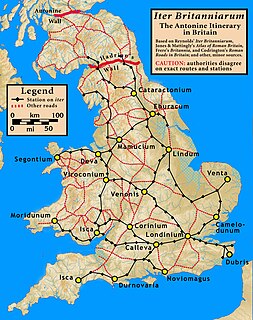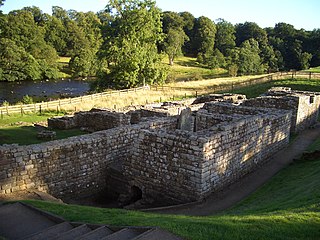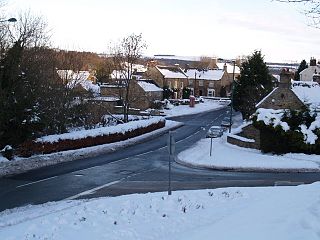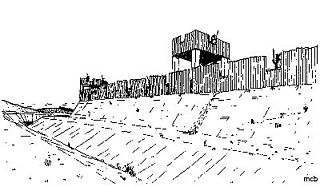
Mercury is a major god in Roman religion and mythology, being one of the 12 Dii Consentes within the ancient Roman pantheon. He is the god of financial gain, commerce, eloquence, messages, communication, travelers, boundaries, luck, trickery and thieves; he also serves as the guide of souls to the underworld.
In Romano-British culture and Germanic polytheism, the Alaisiagae were a pair of Celtic and Germanic goddesses deifying victory.

There are many Roman sites in Great Britain that are open to the public. There are also many sites that do not require special access, including Roman roads, and sites that have not been uncovered.

Housesteads Roman Fort is the remains of an auxiliary fort on Hadrian's Wall. Its ruins are at Housesteads in the civil parish of Bardon Mill in Northumberland, England, south of Broomlee Lough. The fort was built in stone around AD 124, soon after the construction of the wall began in AD 122 when the area was part of the Roman province of Britannia. Its name has been variously given as Vercovicium, Borcovicus, Borcovicium, and Velurtion. The name of the 18th-century farmhouse of Housesteads gives the modern name. The site is owned by the National Trust and is in the care of English Heritage. Finds can be seen in the site museum, in the museum at Chesters, and in the Great North Museum: Hancock in Newcastle upon Tyne.
Verostonos was a god in ancient Celtic polytheism, worshipped in Roman Britain. His name links him to alder-trees. Altar-stones raised to him have been recovered in the United Kingdom, such as that at Ebchester in County Durham . His association with Cocidius in that inscription suggests that he may have been linked with, or an epithet of, that more widely attested war god.
Tridamos is the male deification of supposed bovine triplication in ancient Celtic polytheism, conceived as a manifestation of abundance.
Mogons or Moguns was a Celtic god worshiped in Roman Britain and Gaul. The main evidence is from altars dedicated to the god by Roman soldiers.

The Hadrian's Wall Path is a long-distance footpath in the north of England, which became the 15th National Trail in 2003. It runs for 84 miles (135 km), from Wallsend on the east coast of England to Bowness-on-Solway on the west coast. For most of its length it is close to the remains of Hadrian's Wall, the defensive wall built by the Romans on the northern border of their empire. This is now recognised as part of the "Frontiers of the Roman Empire" World Heritage Site.
John Clayton was an antiquarian and town clerk of Newcastle upon Tyne, England, during the nineteenth century. He worked with the builder Richard Grainger and architect John Dobson to redevelop the centre of the city in a neoclassical style, and Clayton Street in Newcastle is named after him. He did much to preserve the remains of Hadrian's Wall.

Magnis was a Roman fort on Hadrian's Wall in northern Britain. Its ruins are now known as Carvoran Roman Fort and are located near Carvoran, Northumberland, in northern England. It is thought to have been sited with reference to the Stanegate Roman road, before the building of Hadrian's Wall, to which it is not physically attached. In fact the Vallum ditch unusually goes north of the fort, separating it from the Wall.

Cilurnum or Cilurvum was a fort on Hadrian's Wall mentioned in the Notitia Dignitatum. It is now identified with the fort found at Chesters near the village of Walwick, Northumberland, England. It was built in 123 AD, just after the wall's completion.

Carrawburgh is a settlement in Northumberland. In Roman times, it was the site of a 3 1⁄2-acre (1.5 ha) auxiliary fort on Hadrian's Wall called Brocolitia, Procolita, or Brocolita. This name is probably based on the Celtic name for the place, and one possible translation put forward is 'badger holes'. The fort there was a mile or so west of the Wall's northernmost point at Limestone Corner, and just over a mile west of the nearest milecastle, Milecastle 30. The fort either used the Wall itself as its northern rampart, or was built parallel to it but detached. It certainly postdates both the Wall and the vallum.

Vindomora was an auxiliary fort on Dere Street, in the province of Lower Britain. Its ruins, now known as Ebchester Roman Fort, are situated at Ebchester in the English county of Durham, to the north of Consett and 12 miles (19 km) west-south-west from Newcastle upon Tyne.

Concangis was an auxiliary castra in the Roman province of Lower Britain. Its ruins are located in Chester-le-Street, Durham, in England, and are now known as Chester-le-Street Roman Fort. It is situated 6 miles (10 km) north of Durham and 8 miles (13 km) south of Newcastle upon Tyne.

Condercum was a Roman fort on the site of the modern-day Condercum Estate in Benwell, a suburb of Newcastle upon Tyne, England. It was the third fort on Hadrian's Wall, after Segedunum (Wallsend) and Pons Aelius (Newcastle), and was situated on a hilltop 2 miles (3 km) to the west of the city. Today, nothing can be seen of the fort or its adjoining wall, as the site is covered by a modern reservoir and housing estate, bisected by the A186 Newcastle to Carlisle road, which follows the line of Hadrian's Wall. The remains of a small temple dedicated to Antenociticus, a local deity, can be seen nearby, and the original causeway over the vallum, or rear ditch, can also be seen. A modern-day Condercum Road marks the site.

Aesica was a Roman fort, one and a half miles north of the small town of Haltwhistle in Northumberland, England. It was the ninth fort on Hadrian's Wall, between Vercovicium (Housesteads) to the east and Magnis (Carvoran) to the west. Its purpose was to guard the Caw Gap, where the Haltwhistle Burn crosses the Wall. The B6318 Military Road passes about half a mile to the south of the fort.

Hadrian's Wall, also known as the Roman Wall, Picts' Wall, or Vallum Hadriani in Latin, is a former defensive fortification of the Roman province of Britannia, begun in AD 122 in the reign of the emperor Hadrian. It ran from the banks of the River Tyne near the North Sea to the Solway Firth on the Irish Sea, and allowed the Roman Empire to project power some distance to the north, into the lands of the northern Ancient Britons, including the Picts.

Toutatis or Teutates is a Celtic god who was worshipped in ancient Gaul and Britain. On the basis of his name's etymology, he has been widely interpreted to be a tribal protector.
According to classical sources, the ancient Celts were animists. They honoured the forces of nature, saw the world as inhabited by many spirits, and saw the Divine manifesting in aspects of the natural world.

Chesters Bridge was a Roman bridge over the River North Tyne at Chollerford, Northumberland, England, and adjacent to Chesters Roman fort on Hadrian's Wall. The fort, mentioned in the Notitia Dignitatum, and now identified with the fort found at Chesters, was known as Cilurnum or Cilurvum.















